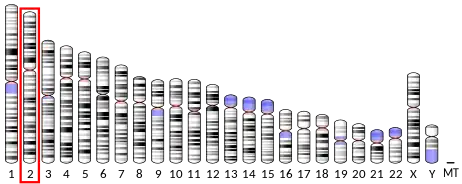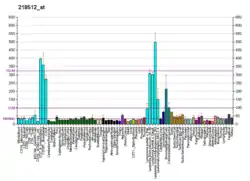Ribosome biogenesis protein WDR12 is a protein that in humans is encoded by the WDR12 gene on chromosome 2.[5][6][7] It is ubiquitously expressed in many tissues and cell types.[8] WDR12 participates in ribosome biogenesis and cell proliferation as a component of the PeBoW complex.[5] This protein is associated with cardiovascular diseases such as coronary artery disease and myocardial infarction.[9] The PCSK9 gene also contains one of 27 loci associated with increased risk of coronary artery disease.[10]
Structure
Gene
The WDR12 gene resides on chromosome 2 at the band 2q33.2 and includes 13 exons.[7]
Protein
WDR12 is a member of the WD repeat WDR12/YTM1 family and contains 7 WD repeats.[11][5] Each WD repeat typically contains a C-terminal tryptophan-aspartic acid dipeptide and an N-terminal glycine-histidine dipeptide.[12] Disruption of these 7 WD repeats tampers with the predicted propeller-like structure formed and, consequently, its nucleolar localization.[5] At the N-terminus of WDR12 lies a ubiquitin-like (UBL) domain, which contains β-grasp fold similar to that found in ubiquitin. The UBL domain binds the motor protein midasin and facilitates release of the PeBoW complex, which is composed of WDR12, Pescadillo 1 (PES1), and Block of proliferation 1 (BOP1), from pre-ribosomal particles.[12][13]
Function
The WDR12 gene is ubiquitously expressed during embryogenesis, and high levels are found in the thymus and testis of adult mice.[5] It is a crucial factor in the mammalian ribosome biogenesis pathway that forms a stable complex named PeboW with Pes1 and Bop1.[5][6] WDR12 is required for processing of the 32S precursor rRNA without affecting the synthesis of the 45S/47S primary transcript and it functions in the maturation of the 60S ribosomal subunit. Depletion of WDR12 severely inhibits cell proliferation.[6] It is observed that WDR12 siRNA silencing in vitro resulted in decreased phosphorylation of p38 MAPK, HSP27, and ERK1/2 in neonatal myocytes, which may partially elucidate the mechanistic role of WDR12 in the regulation of cell proliferation, differentiation, and survival.[14][15] Given the evidence of in vitro binding of WDR12 to the cytoplasmic domain of Notch1, it is postulated that WDR12 also functions in the modulation of Notch signaling activity.[16]
Clinical significance
In humans, a large genome-wide association study (GWAS) identified several single nucleotide polymorphisms (SNPs) that were reproducible and strongly associated with a risk for coronary artery disease and myocardial infarction (i.e., heart attacks). In this large genetic study, a total of 46 genomic loci were linked to variations in susceptibility to coronary artery disease.[17] Within the 46 genome-wide SNPs, 12 indicated an association with a lipid levels and 5 showed significant association with high blood pressure. Accordingly, one of the most strongly associated variants was located on the WDR12 locus, which was also initially associated with the risk of early-onset myocardial infarction.[17] However, its exact cellular and functional role in the heart is still being identified.
Biomarker
The expression of WDR12 in the rat heart and the human heart was studied using WDR12 gene delivery to examine the direct functional and structural effects of WDR12 on cardiac maladaptive remodeling, in particular the left ventricle. This recent study revealed that overexpression of WDR12 by gene delivery could deteriorate both systolic and diastolic function of the rat heart. Likewise, subsequent analysis of a cohort of 1400 human subjects corroborated that the WDR12 variant was associated with diastolic dysfunction.[12]
Additionally, a multi-locus genetic risk score study, based on a combination of 27 loci including the WDR12 gene, identified individuals at increased risk for both incidence and recurrent coronary artery disease events, as well as an enhanced clinical benefit from statin therapy. The study was based on a community cohort study (the Malmo Diet and Cancer study) and four additional randomized controlled trials of primary prevention cohorts (JUPITER and ASCOT) and secondary prevention cohorts (CARE and PROVE IT-TIMI 22).[10]
Interactions
Interactive Pathway Map
WDR12 participates in interactions within the major pathway of rRNA processing in the nucleolus.
References
- 1 2 3 GRCh38: Ensembl release 89: ENSG00000138442 - Ensembl, May 2017
- 1 2 3 GRCm38: Ensembl release 89: ENSMUSG00000026019 - Ensembl, May 2017
- ↑ "Human PubMed Reference:". National Center for Biotechnology Information, U.S. National Library of Medicine.
- ↑ "Mouse PubMed Reference:". National Center for Biotechnology Information, U.S. National Library of Medicine.
- 1 2 3 4 5 6 Hölzel M, Rohrmoser M, Schlee M, Grimm T, Harasim T, Malamoussi A, Gruber-Eber A, Kremmer E, Hiddemann W, Bornkamm GW, Eick D (August 2005). "Mammalian WDR12 is a novel member of the Pes1-Bop1 complex and is required for ribosome biogenesis and cell proliferation". The Journal of Cell Biology. 170 (3): 367–78. doi:10.1083/jcb.200501141. PMC 2171466. PMID 16043514.
- 1 2 3 Rohrmoser M, Hölzel M, Grimm T, Malamoussi A, Harasim T, Orban M, Pfisterer I, Gruber-Eber A, Kremmer E, Eick D (May 2007). "Interdependence of Pes1, Bop1, and WDR12 controls nucleolar localization and assembly of the PeBoW complex required for maturation of the 60S ribosomal subunit". Molecular and Cellular Biology. 27 (10): 3682–94. doi:10.1128/MCB.00172-07. PMC 1899993. PMID 17353269.
- 1 2 "Entrez Gene: WDR12 WD repeat domain 12".
- ↑ "BioGPS - your Gene Portal System". biogps.org. Retrieved 2016-08-23.
- ↑ Myocardial Infarction Genetics Consortium (March 2009). "Genome-wide association of early-onset myocardial infarction with single nucleotide polymorphisms and copy number variants". Nature Genetics. 41 (3): 334–41. doi:10.1038/ng.327. PMC 2681011. PMID 19198609.
- 1 2 Mega JL, Stitziel NO, Smith JG, Chasman DI, Caulfield MJ, Devlin JJ, Nordio F, Hyde CL, Cannon CP, Sacks FM, Poulter NR, Sever PS, Ridker PM, Braunwald E, Melander O, Kathiresan S, Sabatine MS (June 2015). "Genetic risk, coronary heart disease events, and the clinical benefit of statin therapy: an analysis of primary and secondary prevention trials". Lancet. 385 (9984): 2264–71. doi:10.1016/S0140-6736(14)61730-X. PMC 4608367. PMID 25748612.
- ↑ "WDR12 - Ribosome biogenesis protein WDR12 - Homo sapiens (Human) - WDR12 gene & protein". www.uniprot.org. Retrieved 2016-08-23.
- 1 2 3 Moilanen AM, Rysä J, Kaikkonen L, Karvonen T, Mustonen E, Serpi R, Szabó Z, Tenhunen O, Bagyura Z, Näpänkangas J, Ohukainen P, Tavi P, Kerkelä R, Leósdóttir M, Wahlstrand B, Hedner T, Melander O, Ruskoaho H (2015-01-01). "WDR12, a Member of Nucleolar PeBoW-Complex, Is Up-Regulated in Failing Hearts and Causes Deterioration of Cardiac Function". PLOS ONE. 10 (4): e0124907. Bibcode:2015PLoSO..1024907M. doi:10.1371/journal.pone.0124907. PMC 4411154. PMID 25915632.
- ↑ Romes EM, Sobhany M, Stanley RE (January 2016). "The Crystal Structure of the Ubiquitin-like Domain of Ribosome Assembly Factor Ytm1 and Characterization of Its Interaction with the AAA-ATPase Midasin". The Journal of Biological Chemistry. 291 (2): 882–93. doi:10.1074/jbc.M115.693259. PMC 4705406. PMID 26601951.
- ↑ Rose BA, Force T, Wang Y (October 2010). "Mitogen-activated protein kinase signaling in the heart: angels versus demons in a heart-breaking tale". Physiological Reviews. 90 (4): 1507–46. doi:10.1152/physrev.00054.2009. PMC 3808831. PMID 20959622.
- ↑ Willis MS, Patterson C (October 2010). "Hold me tight: Role of the heat shock protein family of chaperones in cardiac disease". Circulation. 122 (17): 1740–51. doi:10.1161/CIRCULATIONAHA.110.942250. PMC 2976481. PMID 20975010.
- ↑ Nal B, Mohr E, Silva MI, Tagett R, Navarro C, Carroll P, Depetris D, Verthuy C, Jordan BR, Ferrier P (January 2002). "Wdr12, a mouse gene encoding a novel WD-Repeat Protein with a notchless-like amino-terminal domain". Genomics. 79 (1): 77–86. doi:10.1006/geno.2001.6682. PMID 11827460.
- 1 2 Kathiresan S, Voight BF, Purcell S, Musunuru K, Ardissino D, Mannucci PM, et al. (March 2009). "Genome-wide association of early-onset myocardial infarction with single nucleotide polymorphisms and copy number variants". Nature Genetics. 41 (3): 334–41. doi:10.1038/ng.327. PMC 2681011. PMID 19198609.
Further reading
- Andersen JS, Lyon CE, Fox AH, Leung AK, Lam YW, Steen H, Mann M, Lamond AI (January 2002). "Directed proteomic analysis of the human nucleolus". Current Biology. 12 (1): 1–11. doi:10.1016/S0960-9822(01)00650-9. PMID 11790298. S2CID 14132033.
- Nal B, Mohr E, Silva MI, Tagett R, Navarro C, Carroll P, Depetris D, Verthuy C, Jordan BR, Ferrier P (January 2002). "Wdr12, a mouse gene encoding a novel WD-Repeat Protein with a notchless-like amino-terminal domain". Genomics. 79 (1): 77–86. doi:10.1006/geno.2001.6682. PMID 11827460.
- Scherl A, Couté Y, Déon C, Callé A, Kindbeiter K, Sanchez JC, Greco A, Hochstrasser D, Diaz JJ (November 2002). "Functional proteomic analysis of human nucleolus". Molecular Biology of the Cell. 13 (11): 4100–9. doi:10.1091/mbc.E02-05-0271. PMC 133617. PMID 12429849.
- Andersen JS, Lam YW, Leung AK, Ong SE, Lyon CE, Lamond AI, Mann M (January 2005). "Nucleolar proteome dynamics". Nature. 433 (7021): 77–83. Bibcode:2005Natur.433...77A. doi:10.1038/nature03207. PMID 15635413. S2CID 4344740.
- Higa LA, Wu M, Ye T, Kobayashi R, Sun H, Zhang H (November 2006). "CUL4-DDB1 ubiquitin ligase interacts with multiple WD40-repeat proteins and regulates histone methylation". Nature Cell Biology. 8 (11): 1277–83. doi:10.1038/ncb1490. hdl:10397/34293. PMID 17041588. S2CID 22180568.




